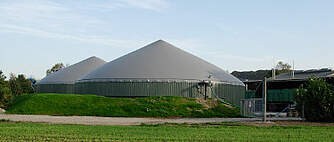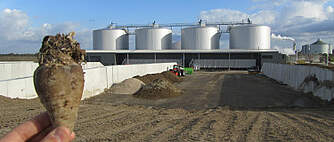Agricultural substrates for biogas plants
Liquid manure is particularly used in agricultural biogas plants as a basic fermentation substrate. As well as liquid manure or dung, crop residues or feed residues are generated in agriculture, and these can be used in biogas plants. Energy crops are cultivated specifically for use in biogas plants.
Liquid manure is the oldest substrate used in biogas plants. The natural methane bacteria content of liquid cattle manure makes it ideal for the inoculation of biogas fermenters, and fermentation in the biogas plant not only generates energy, it also reduces methane and nitrous oxide emissions. In the fermenter, liquid manure keeps the PH value within the neutral range with its good buffer capacity. The high nutrient content of liquid manure also makes it ideal for mixed fermentation with other substrates and provides a stable fermenter biology.
Reference projects:
- RiHa (Germany): 2012, 500 kWel liquid cattle manure, corn silage
- Neißetal (Germany): 2011, 716 kWel; liquid pig manure and dung, cattle dung, alfalfa silage, corn silage, sugar beet
- Porta (Spain): 2007, 382 kWel liquid pig manure, waste
In recent years there has been much discussion regarding the suitability of straw as a crop residue, since large quantities of straw remain unused all over the world. Following pre-treatment, straw can be used in conjunction with liquid manure in the biogas plant, however it is always important to consider whether it does not make more sense to make thermal use of the already dry material. We find it interesting that with corn there is the option of harvesting the corn crop while simultaneously harvesting the cobs. If the correct variety is chosen, the crop is still green and can still be preserved by ensilage. This makes it easier to digest in the biogas plant.
Reference projects:
- Consultation on various projects in China; GIZ 2010; Corn straw
- Uelzen (Germany): 2002; 134 kWel; liquid pig manure, onion/potato waste, energy crops
- Fabel (Germany): 2001; 220 kWel; liquid pig manure, energy crops, crop residues
Energy crops are specifically cultivated for renewable energy generation. Silage maize is particularly suitable thanks to its high yield per unit of area, its excellent manageability in the biogas plant and its good fermentability. 2-3.5 kWel can be produced per hectare (with rapeseed oil only producing 0.3-0.6 kWhel/ha). Examples of other energy crops are whole-plant cereal, sugar beet or sorghum. Other crops (flowering plants, perennials, etc.) are currently being tested to increase diversity across agricultural areas. In 2002, Krieg & Fischer developed for the first time a biogas plant (Obernjesa near Göttingen) where energy crop silage is wet fermented without liquid manure or other liquid infeed. As a result, in 2003 Krieg & Fischer Ingenieure GmbH received the Innovation Award of the district of Göttingen.
Reference projects:
- Basiliano (Italy): 2012; 625 kWel; triticale and corn silage
- Falkenstein (Germany): 2008; 1.432 kWel; corn silage, sweet sorghum silage, whole crop silage
- Körber (Germany): 2003; 110 kWel; energy crops; 1st plant without liquid manure
Grass can vary greatly in terms of quality. There's high-quality grass silage from permanent grassland, but also green waste and grass cuttings from green spaces, grass scrapings from roadsides or grass from landscape conservation, which is only mowed in late summer. Therefore the biogas yield also varies considerably. While high-quality grass silage, which also has a high feed value, produces high gas yields, the gas yield from landscape conservation grass, which is only mowed in late summer, is significantly lower due to its high raw fibre and lignin content. Biologically and mechanically, grass is not as easy to handle in the biogas plant as corn silage: Floating layer formation or entangled fibres can be problematic and must be minimised by taking procedural measures. Roadside grass scrapings or roadside vegetation may also have an increased proportion of impurities and must be pre-treated. Digestate can be spread on grassland over considerably longer periods than is the case with arable land. This means that the required storage capacity for digestate is smaller.
Reference projects:
- Dietz (Germany): 2012; 191 kWel; liquid cattle manure, cattle dung, grass silage, corn silage, whole crop silage
- Forcate (Italy): 2010; 365 kWel; grass and corn silage
- Gut Altenhof (Germany): 2009; 365 kWel; corn silage, whole crop silage, grain, grass silage


